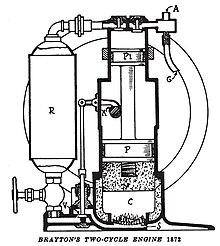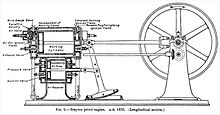Quick Facts

Biography
- For the politician, see George Brayton (state senator).
George Brayton (October 3, 1830 – December 17, 1892) was born in Rhode Island, son of William H. and Minerva (Bailey) Brayton. He was an American mechanical engineer who lived with his family in Boston and who is noted for introducing the constant pressure engine that is the basis for the gas turbine, and which is now referred to as the Brayton cycle.
Brayton's Ready Motor



In 1872 George Brayton patented a constant pressure internal combustion engine, initially using vaporized gas but later using liquid fuels such as kerosene and oil, known as Brayton's Ready Motor, The engine used one cylinder for compression, a receiver reservoir, and a separate power/expander cylinder in which the products of combustion expanded for the power stroke. The significant difference from other piston driven internal combustion engines is that the two cylinders are arranged so that the fuel/air mixture burns progressively at constant pressure as it is transferred from the compressor cylinder and reservoir to the working/expansion cylinder. In the original version a gas/air mixture was created by a heated-surface carburetor, then compressed and stored in a reservoir where it was ignited and then introduced into an expansion cylinder. A metal gauze/mesh was used to prevent the combustion running back to the reservoir. However at times the mesh failed, leading to flash-back or explosion. In 1874 Brayton filed a patent for a liquid fuel injection system. In this version, fuel was introduced as the air passed into the expansion cylinder, thus eliminating the explosion problem. Ignition remained a pilot flame. The principle was referred to as constant pressure combustion, and had been attempted without success by Sir William Siemens c1861 using a 4-cylinder engine with a separate combustion chamber. Brayton not only achieved success in making the constant pressure cycle work, but he also made and marketed a commercial product.
Brayton cycle engines were some of the first engines to be used for motive power. In 1881 John Philip Holland used a Brayton engine to power the world's first successful self-propelled submarine, the Fienian Ram.
Also the Selden auto of 1878 used a Brayton cycle engine. This design never actually ran. When the Brayton engine was applied to an omnibus in 1878 as part of a project between Brayton and the engineers George and James Fawcett the latter described the attempt as a 'complete failure'.

The engine's cycle of operations including sectional drawings and indicator diagrams for both gas and petroleum fueled versions. Details of the way the liquid fuel was introduced are described over 11 pages of Dugald Clerk's book Gas and Oil Engines. The petroleum engine in these tests was made by the "New York and New Jersey Ready Motor Company". This is followed by a similar analysis of Simon's engine which was an adaptation of the Brayton engine made by Louis Simon & Sons, in Nottingham, UK and marketed as The Eclipse Silent Gas Engine. The Simon engine had an added complexity in that it injected some of the water/steam heated by the engine/exhaust into the engine. The indicator diagrams for this engine are also reported by Dugald Clerk and show that the addition of the water has little merit in terms of power production, the cooling of the gases and expansion of the steam compensating for each other.
Because the Brayton engine had a slow progressive burn of the fuel/air mixture it was possible to maintain a pilot flame, and so the engine, once lit, needed no form of ignition system. The measured efficiency of the gas engine was intermediate between that of the Lenoir/Hugon engines, and the Otto & Langen atmospheric engine, but the liquid fueled Brayton engine had an advantage in not requiring a gas supply.
The early Brayton gas engine had the engine speed governed by varying the point of cut-off for the admission of the combusted gases into the power cylinder, and the admissions of gas and air to the pump was similarly regulated to maintain the reservoir pressure. The liquid fueled engine reported by Clerk only regulated the cut-off to the power cylinder, and used a pressure relief valve to limit the reservoir air pressure. The reservoir on the Brayton engine allowed it to be readily started if it remained pressurized, though Clerk states that "leakage and loss were so frequent that the apparatus was of little use."
Brayton's engine was displayed at the Centennial Exposition in Philadelphia in 1876, and the Simon variant was displayed at the 1878 Paris Exhibition, and for a few years was well regarded, but within a short time the Otto engine became more popular. However, it was considered the first safe and practical oil engine and also served as inspiration to George B. Selden. As a production engine the design evolved over time, and according to Henry de Graffigny in Gas and Petroleum Engines, it was available in both vertical and horizontal forms.
A Brayton Engine is preserved in the Smithsonian Institution in the American History museum, and a later Brayton engine which powered one of John Philip Holland's early submarines is preserved in the Paterson Museum in the Old Great Falls Historic District of Paterson, New Jersey.
Brayton's contributions to the Diesel engine


In 1890 Brayton patented a 4 stroke engine with an air blast fuel injection system. Diesel's first engines used an air blast atomization system that was very similar to Brayton's . Unlike Diesel's engine Brayton's engine was fairly low compression. The ignition source was a constantly glowing mesh of platinum.
Later Diesel engines used a system of high pressure fuel injection nearly identical to Brayton's 1887 engine where the fuel was admitted into the combustion area as it passed through a spring loaded relief nozzle, This caused the fuel to become much more combustable. Here is the discovery in Brayton's own words " “I have discovered that heavy oils can be mechanically converted into a finely-divided condition within a firing portion of the cylinder, or in a communicating firing chamber.” Another part reads “I have for the first time, so far as my knowledge extends, regulated speed by variably controlling the direct discharge of liquid fuel into the combustion chamber or cylinder into a finely-divided condition highly favorable to immediate combustion.” US Patent #432114
